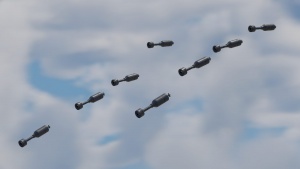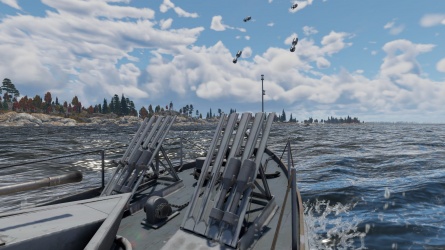7.2 in T37
Contents
Description
Write an introduction to the article in 2-3 small paragraphs. Briefly tell us about the history of the development and combat using the weaponry and also about its features. Compile a list of air, ground, or naval vehicles that feature this weapon system in the game.
Vehicles equipped with this weapon
General info
Tell us about the tactical and technical characteristics of the bomb.
Effective damage
Describe the type of damage produced by this type of bomb (high explosive, splash damage, etc.)
Comparison with analogues
Compared to its peers, 7.2 in T37 has one of the smallest explosive fillers. Also, quite unusually, it's launched forward off a fixed-mount launcher.
| Name | Country of origin |
Mass (kg) | Explosive type |
Explosive mass (kg) |
TNT equivalent (kg) |
|---|---|---|---|---|---|
| 7.2 in T37 | |
29 | Torpex | 15.9 | 25.44 |
| B TG | |
63 | TNT | 50 | 50 |
| B TG 100 | |
126 | TNT | 100 | 100 |
| BAS | |
160 | Torpex | 70 | 112 |
| BB-1 | |
165 | TNT | 130 | 130 |
| BM-1 | |
45 | TNT | 25 | 25 |
| Guiraud | |
176 | TNT | 130 | 130 |
| K-gun Mk.9 | |
190 | TNT | 136 | 136 |
| Limbo mortar | |
177 | Minol | 94 | 108.1 |
| Mk.6 | |
190 | TNT | 136 | 136 |
| Mk.6 mortar | |
190 | TNT | 136 | 136 |
| Mk.9 | |
190 | TNT | 136 | 136 |
| Mk.10 Hedgehog mortar | |
29 | Torpex | 15.9 | 25.44 |
| Mk.VII | |
196 | TNT | 130 | 130 |
| RBM mortar | |
160 | Amatol | 70.8 | 70.8 |
| Type 3 | |
50 | Type 88 | 20 | 26 |
| Type 95 | |
160 | Amatol | 100 | 100 |
| WBD | |
196 | Amatol | 130 | 130 |
| WBF | |
139 | Amatol | 60 | 60 |
| WBG | |
160 | Amatol | 100 | 100 |
| Y-gun Mk.VII | |
196 | TNT | 130 | 130 |
Usage in battles
Describe situations when you would utilize this bomb in game (vehicle, pillbox, base, etc.)

Pros and cons
Summarise and briefly evaluate the weaponry in terms of its characteristics and combat effectiveness. Mark pros and cons as a list.
Pros:
Cons:
History
The field of anti-submarine warfare was first truly developed during World War I when German U-boats turned the submarine into a truly practical piece of naval operations. The United States made its first depth charges from a design originating in the UK and during World War II, the two nations would continue cooperation in making new ASW weapons. The United States Navy adopted the British Mk.10 Hedgehog mortar designed in late 1942 as their first forward-firing ASW weapon. The Hedgehog was more effective than conventional depth charges as it only detonated when it hit the enemy submarine which allowed for more damage and reduced disruption to the sonar tracking.
While the Hedgehog was an effective design, it was too large for mounting on smaller ships in the US Navy such as corvettes or frigates. In response, the Mark 20 Mousetrap was created to be a similar weapon that could launch anti-submarine explosives off the deck of a US Navy ship. A problem with the spigot mortar system used by the Hedgehog was it places considerable stress on the deck when fired so they used launch rails instead that launched the projectiles. Unlike the Hedgehog, the Mousetrap uses rockets that burned for .2 to .7 seconds to launch the explosive into the water. The launchers originally used 85-pound projectiles before the decision was made to use the lighter 65-pound projectiles shared in the Hedgehog. The 7.2-inch rockets carried 31 pounds of TNT or Torpex (42% RDX 40% TNT and 18% powdered aluminum) warheads which added 1.5 pounds to the weight. It was not as effective as the Hedgehog due to the fact it fired at a fixed 48-degree elevation and couldn't compensate for rolling. However, it filled the vital niche of arming smaller ASW ships such as SC-497 and PC-451.
The 7.2-inch T37 Demolition Rocket is an explosive rocket developed from the projectiles used by the Mousetrap. It used a standard 2.25-inch rocket motor and a 32-pound C2 explosive warhead. Intended for use against concrete bunkers, the T37 was first designed by Caltech before the design was given to the US Navy in July 1944. The rockets first saw combat in August during Operation Dragoon, the landings in Provence, Southern France. The rockets were used for coastal barrages from Landing Craft Rocket craft in 120-round "Woofus" mounts. The rockets were later on tanks in the T40 "Whiz Bang" 20-round that fired a full barrage of rockets in 10 seconds. The other mount was a 24-round "Grand Slam" mount also for tanks. Despite the extra destructive power, the tank mounts were not popular because they blocked the turret hatches.
Media
Excellent additions to the article would be video guides, screenshots from the game, and photos.
See also
Links to the articles on the War Thunder Wiki that you think will be useful for the reader, for example:
- reference to the article about the variant of the weapon;
- references to approximate analogues by other nations and research trees.
External links
Paste links to sources and external resources, such as:
- topic on the official game forum;
- other literature.
| Naval special armaments | |
|---|---|
| USA | |
| Mortars | 7.2-inch T37 · Mk 2 |
| Rockets | 5-inch GPSR Mk.7 · Mark 108 Weapon alfa |
| Missiles | RIM-24A |
| Germany | |
| Rockets | M/50 Bofors |
| Missiles | Strela-2M |
| USSR | |
| Mortars | BM-37 · RBM · RBU-1200 · RBU-2500 · RBU-6000 · RKU-36U |
| Rockets | BM-14-17 · BM-21 · M13 · M-8 |
| Missiles | Volna-M |
| Britain | |
| Mortars | Ordnance ML 4.2-inch mortar |
| Japan | |
| Rockets | 4.5-inch BBR Mk.7 (USA) · Mark 108 Weapon alfa (USA) |
| Italy | |
| Missiles | Nettuno |




